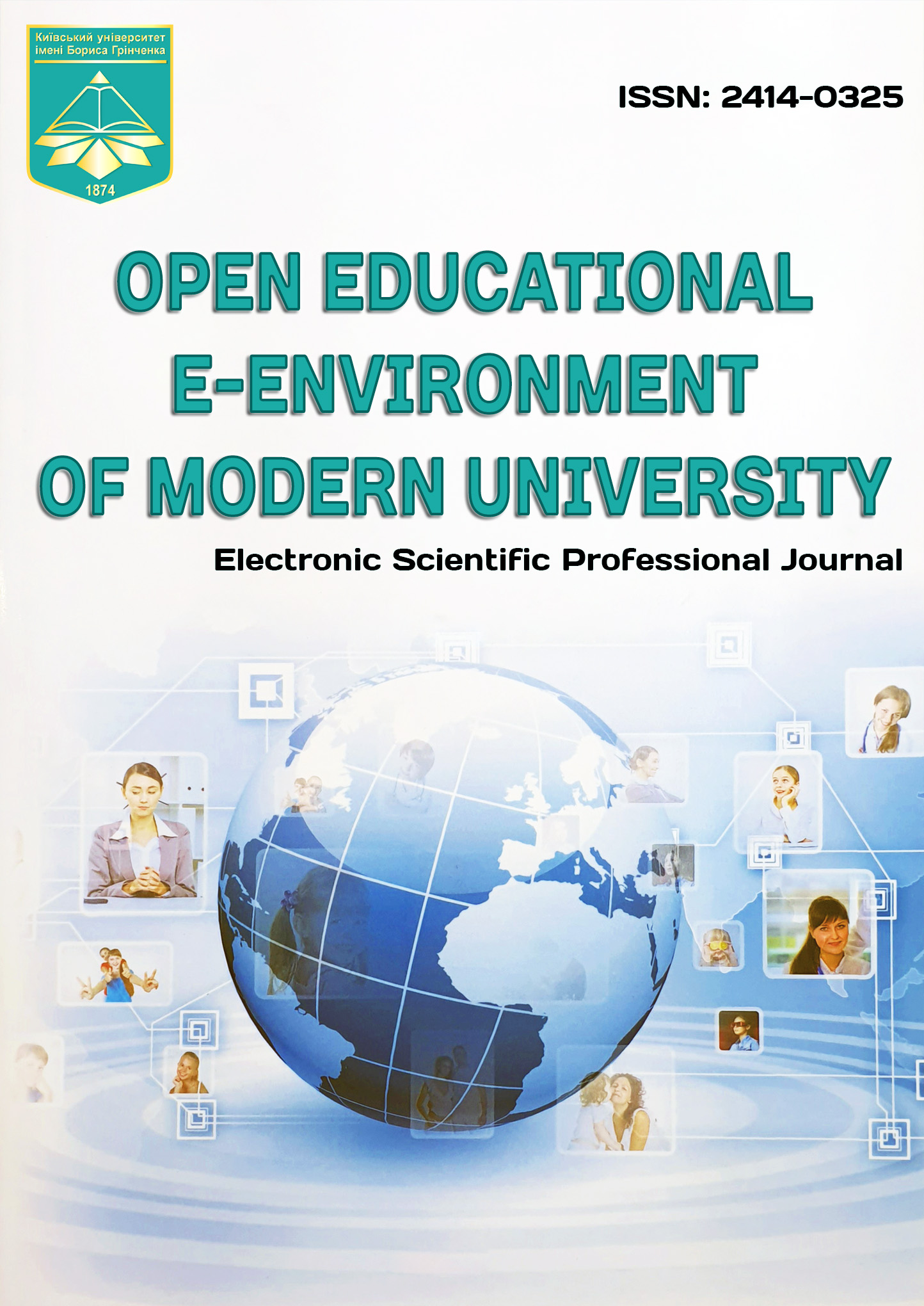RATING OF THE RESEARCH ACTIVITY OF HIGHER EDUCATION INSTITUTIONS ACADEMIC STAFF AS A TOOL FOR ENSURING THE TRANSPARENCY OF RESEARCH RESULTS
DOI:
https://doi.org/10.28925/2414-0325.2022.1311Keywords:
research activity; analysis of research activities; rating system; scientometric databases; citation; h-index; i10-indexAbstract
A key aspect of increasing the level of competitiveness of a higher education institution is participation in international and domestic ratings, therefore it is important to ensure quality and open, transparent presentation of the results of all types of educational activities of a higher education institution, especially research. The development and implementation of internal ratings, the methodology of which reflects the methodology of key educational ratings, is important for the analysis of the dynamics of indicators of a higher education institution. The article analyzes the most common scientometric databases used to evaluate the results of scientific research – Scopus, Web of Science, Google Scholar, Semantic Scholar, Dimensions. The experience of Ukrainian universities in building ratings of scientists based on indicators of the effectiveness of research activity in scientometric databases is analyzed. Transparency rating based on citation rates in Google Scholar, implemented at Borys Grinchenko Kyiv University, is presented. The transparency rating ranks higher education institutions academic staff according to the indicators of publication activity in the Google Scholar system. The advantages and disadvantages of implementing a rating system for the analysis of the research activity of higher education institutions academic staff have been determined. It is summarized that for the optimal presentation of the results of the research activities of the higher education institutions academic staff, it is important to systematically implement measures to ensure open access to research results, the use of international identifiers of the scientist, the dissemination and distribution of research results on the Internet, filling and updating the profiles of the scientist in the most authoritative scientometric databases, which has a positive effect on the indicators of the research activity of the higher education institution in the educational rankings.
Downloads
References
Call for transformation runs through UNESCO World Higher Education Conference. URL: https://www.unesco.org/en/articles/call-transformation-runs-through-unesco-world-higher-education-conference (дата звернення: 12.09.2022)
Buinytska O., Hrytseliak B., Smirnova V. Rating as assessment tool of quality and competitiveness of university. Open educational e-environment of modern University. 2018. №4. P. 16-32. DOI: https://doi.org/10.28925/2414-0325.2018.1632
Ткачук В. В., Єчкало Ю.В., Семеріков С.О. Рейтинг сучасного науковця як складник рейтингу університету. Розвиток промисловості та суспільства: матеріали Міжнародної науково-технічної конференції ДВНЗ «Криворізький національний університет», м. Кривий Ріг, Україна. 2017. С. 405. URL: http://ds.knu.edu.ua/jspui/bitstream/123456789/792/1/Рейтинг%20сучасного%20науковця%20як%20складник%20рейтингу%20університету.pdf
Морзе Н.В., Буйницька О.П. Система рейтингових показників оцінювання діяльності викладачів сучасних університетів. Науковий часопис НПУ імені М. П. Драгоманова. 2017. №19(26). С. 34-44. URL: http://enpuir.npu.edu.ua/handle/123456789/19082
Буйницька О.П. Система педагогічного проєктування інформаційно-освітнього середовища для здійснення підготовки майбутніх соціальних педагогів: монографія. О. П. Буйницька – Київ: Ун-т ім. Б. Грінченка, 2021. 568 с. URL: https://elibrary.kubg.edu.ua/id/eprint/40182/
Martín-Martín A., Orduna-Malea E., Thelwall M. Google Scholar, Web of Science, and Scopus: A systematic comparison of citations in 252 subject categories. Journal of Informetrics. 2018. №12(4). P. 1160–1177. DOI: https://doi.org/10.1016/j.joi.2018.09.002
Delgado López-Cózar E., Orduña-Malea E., Martín-Martín A. Google Scholar as a Data Source for Research Assessment. Springer Handbook of Science and Technology Indicators, 2019. P. 95–127.
Биков В. Ю., Спірін О. М., Іванова С.М., Вакалюк Т. А., Мінтій І.С., Кільченко А.В. Наукометричні показники оцінювання результативності досліджень наукових установ і закладів освіти. Інформаційні технології і засоби навчання. 2021 №86(6), С. 289-312. DOI: https://doi.org/10.33407/itlt.v86i6.4656
Спірін О. М., Биков В. Ю. Інформаційно-аналітична підтримка науково-педагогічних досліджень на основі електронних бібліометричних систем. Звітна науков-практична конференція Інституту інформаційних технологій і засобів навчання НАПН України, м. Київ, Україна. 2016. С. 1-3. URL: https://lib.iitta.gov.ua/106914/
Semerikov S., Pototskyi V., Slovak K., Hryshchenko S., Kiv A. Automation of the export data from Open Journal Systems to the Russian Science Citation Index. 2018. №2257. P. 215–226. URL: http://ceur-ws.org/Vol-2257/paper21.pdf
Вакаренко О. Наукометричні бази даних: від системи отримання інформації до інструменту оцінювання наукових досліджень. Наука України в світовому інформаційному просторі. 2018. №15. С. 9-15. DOI: https://doi.org/10.15407/akademperiodyka.372.009
Гогунський В. Д., Яковенко В. О., Лященко Т. О., Отрадська Т. В. Загальні механізми формування системи цитування наукових статей. Стратегічне управління, управління портфелями, програмами та проектами Вісник НТУ «ХПІ». 2016. № 1173. С. 14-18. URL: http://repository.kpi.kharkov.ua/handle/KhPI-Press/21430
Martín-Martín A., Orduna-Malea E., Delgado López-Cózar E. Coverage of highly-cited documents in Google Scholar, Web of Science, and Scopus: A multidisciplinary comparison. Scientometrics. 2018. №116(3). С. 2175-2188. DOI: https://doi.org/10.1007/s11192-018-2820-9
Harzing A., Alakangas S. Google Scholar, Scopus and the Web of Science: A longitudinal and cross-disciplinary comparison. Scientometrics. 2016. №.106(2). С. 787-804. DOI: https://doi.org/10.1007/s11192-015-1798-9
Rodgers S., Zhang W. Evaluating reliability of Google Scholar, Scopus, and Web of Science: A study of faculty in U.S. advertising and public relations programs. Journalism and Mass Communication Educator. 2022. №77(3). С. 292-307. DOI: https://doi.org/10.1177/10776958211064687
Garcia-Cano E., López-Ortega E., Alvarez-Icaza L. Productivity and impact analysis of a research and technology development center using Google Scholar information. DATA 2019 - Proceedings of the 8th International Conference on Data Science, Technology and Applications. 2019. С. 160-167. DOI: https://doi.org/10.5220/0007842601600167
Смірнова В.А. Дослідження відкритих цифрових інформаційних систем для аналізу дослідницької діяльності науково-педагогічних працівників закладу вищої освіти. Електронне наукове фахове видання “Відкрите освітнє е-середовище сучасного університету”. 2020. №9. С. 134–144. DOI: https://doi.org/10.28925/2414-0325.2020.9.11
Kulkanjanapiban P., Silwattananusarn T. Comparative analysis of dimensions and Scopus bibliographic data sources: An approach to university research productivity. International Journal of Electrical and Computer Engineering. 2022. №12(1). С. 706-720. DOI: https://doi.org/10.11591/ijece.v12i1.pp706-720
Костенко Л., Симоненко Т., Жабін О. Проект "Бібліометрика української науки": ідея, реалізація, задуми. Вісник Книжкової палати. 2019. №5. С. 30-33. URL: https://lib.iitta.gov.ua/717861/1/Symonenko.pdf
Spivakovsky A., Vinnyk M., Poltoratskiy M., Tarasich Y., Spivakovska Y., Gardner G., Panova K. Information system of scientific activity indicators of scientific organizations: Development status and prospects. Proceedings of the 15th International Conference ICTERI, Kherson, Ukraine, 2019. №2393. P. 220-228 URL: http://ceur-ws.org/Vol-2393/paper_260.pdf
Morze N., Buinytska O., Smirnova V. Designing a rating system based on competencies for the analysis of the University teachers’ research activities. Proceedings of the 9th Workshop on Cloud Technologies in Education, Kryvyi Rih, Ukraine. 2022. №3085. P. 139-153. URL: http://ceur-ws.org/Vol-3085/paper24.pdf
Luparenko L. The use of electronic Open Journal Systems in scientific and pedagogic research: Results of experiment. 2020. №2732. P. 1113–1128. URL: http://ceur-ws.org/Vol-2732/20201113.pdf













1.jpg)








